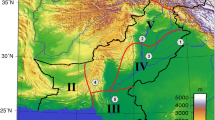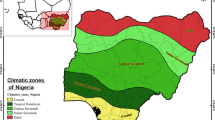Abstract
The aim of this work is to study heat waves (HWs) in Mexicali, Mexico, because numerous deaths have been reported in this city, caused by heatstroke. This research acquires relevancy because several studies have projected that the health impacts of HWs could increase under various climate change scenarios, especially in countries with low adaptive capacity, as is our case. This paper has three objectives: first, to analyze the observed change in the summer (1 June to 15 September) daily maximum temperature during the period from 1951 to 2006; secondly, to characterize the annual and monthly evolution of frequency, duration and intensity of HWs; and finally, to generate scenarios of heat days (HDs) by means of a statistical downscaling model, in combination with a global climate model (HadCM3), for the 2020s, 2050s, and 2080s. The results show summer maximum temperatures featured warming and cooling periods from 1951 until the mid-1980s and, later, a rising tendency, which prevailed until 2006. The duration and intensity of HWs have increased for all summer months, which is an indicator of the severity of the problem; in fact, there are 2.3 times more HWs now than in the decade of the 1970s. The most appropriate distribution for modeling the occurrence of HDs was the Weibull, with the maximum temperature as co-variable. For the 2020s, 2050s, and 2080s, HDs under a medium-high emissions scenario (A2) could increase relative to 1961–1990, by 2.1, 3.6, and 5.1 times, respectively, whereas under a medium-low emissions scenario (B2), HDs could increase by 2.4, 3.4, and 4.0, for the same projections of time.








Similar content being viewed by others
References
Abaurrea J, Asín J, Cebrián AC, Centelles A (2007) Modeling and forecasting extreme hot events in the central Ebro valley, a continental-Mediterranean area. Glob Planet Change 57:43–58
Basu R, Samet J (2003) The relationship between elevated ambient temperature and mortality: a review of the epidemiologic evidence. Epidemiol Rev 24:190–202
Bell ML, O’Neill MS, Ranjit N, Borja-Aburto VH, Cifuentes LA, Gouveia NC (2008) Vulnerability to heat-related mortality in Latin America: a case-crossover study in Sao Paulo, Brazil, Chile and Mexico City, Mexico. Int J Epidemiol. doi:10.1093/ije/dyn094
Beniston M, Díaz HF (2004) The 2003 heat wave as an example of summers in a greenhouse climate? Observations and climate model simulations for Basel, Switzerland. Glob Planet Change 44:73–81
Blashki G, McMichael T, Karoly DJ (2007) Climate change and primary health care Australian Family Physician 36:986–989
Braga AL, Zanobetti A, Schwartz J (2001) The time course of weather-related deaths. Epidemiology 12:662–667
Changnon SA, Kunkel KE, Reinke BC (1996) Impacts and responses to 1995 heat wave: A call of action. Bull Amer Meteor Soc 77:427–430
Cleveland WS (1979) Robust locally weighted regression and smoothing scatterplots. J Amer Statistical Assoc 74:829–836
Curriero FC, Heiner KS, Samet JM, Zeger SL, Strug L, Patz JA (2002) Temperature and mortality in 11 cities of the Eastern United States. Am J Epidemiol 156:193–203
Dessai S (2003) Heat stress and mortality in Lisbon Part II: An assessment of the potential impacts of climate change. Int J Biometeorology 48:37–44
Diaz J, Garcia R, Velázquez de Castro F, Hernández E, López C, Otero A (2002) Effects of extremely hot days on people older than 65 years in Seville (Spain) from 1986 to 1997. Int J Biometeorol 46:145–149
Ebi LK, Meehl AG (2007) Heatwaves & global climate change. The heat is on: climate change & heatwaves in the Midwest. Pew Center on Global Climate Change, Arlington, p 14
Ebi LK, Teisberg JT, Kalkstein SL, Robinson L, Weiher RF (2004) Heat watch/warning systems save lives: estimated costs and benefits for Philadelfia 1995–1998. Bull Amer Meteor Soc 85:1067–1073
EPA (2006) Excessive heat events guidebook. Environmental Protection Agency, Washington 51
Gilleland E, Katz WR (2006) Analyzing seasonal to interannual extreme weather and climate variability with the extremes toolkit. Research Applications Laboratory, National Center for Atmospheric Research. On line: http://www.assessment.ucar.edu/pdf/Gilleland2006revised.pdf
Gover M (1938) Mortality during periods of excessive temperature. Public Health Rep 53:1122–1143
Hayhoe K, Cayan D, Field CP, Frumhoff PE, Maurer PE, Miller LN, Mose CS, Schneider HS, Cahill NK, Cleland EE, Dale L, Drapek R, Hanemann MR, Kalkstein SL, Lenihan J, Lunch KC, Neilson PR, Sheridan CS, Verville HJ (2004) Emission pathways, climate change, and impacts in California. Proc Natl Acad Sci USA 101:12422–12427
IPCC (2007) Climate change 2007: the physical science basis, Working Group I Contribution to the IPCC fourth assessment report. In: Solomon S, Qin D, Manning M, Chen Z, Marquis M, Averyt KB, Tignor M, Miller HL (eds) Observations: atmospheric surface and climate change. Cambridge University Press, New York, pp 235–336
Kalkstein LS, Greene DJ (1997) Evaluation of climate/mortality relationships in large US cities and the possible impacts of climate change. Environ Health Perspect 105:84–93
Kalkstein LS, Sheridan SC (2007) The social impacts of the heat-health watch/warning system in Phoenix, Arizona: assessing the perceived risk and response of the public. Int J Biometeorol 52:43–55
Kalkstein LS, Sheridan SC, Kalkstein AJ (2009) Heat/health warning systems: development, implementation and intervention activities. Biometeorology for adaptation to climate variability and change. Springer-Verlag, Heidelberg, pp 33–48. doi:10.1007/978-1-4020—8921-3_3
Karl TR, Knight RW (1997) The 1995 Chicago heat wave. How likely is a recurrence? Bull Amer Meteor Soc 78:1107–1119
Karl TR, Trenberth KE (2003) Modern global climate change. Science 302:1719–1723
Kovats SR, Ebi LK (2006) Heatwaves and public health in Europe. Eur J Public Health 16:592–599
Kunkel KE, Changnon SA, Reinke BC, Arritt RW (1996) The July 1995 heat wave in the Midwest: a climatic perspective and critical weather factors. Bull Amer Meteor Soc 77:1507–1518
Kyselý J (2004) Mortality and displaced mortality Turing heat waves in the Czech Republic. Int J Biometeorol 49:91–97
Kyselý J, Kalkova J, Kvéton V (2000) Heat waves in the south moravian during the period 1961–1995. Studia geoph et geod 44:57–72
McMichael AJ, Wilkinson P, Kovats RS, Pattenden S, Hajat S, Armstrong B, Vajanapoom N, Niciu EM, Mahomed H, Kingkeow C, Kosnik M, O’Neill MS, Romieu I, Ramirez-Aguilar M, Barreto ML, Gouveia N, Nikiforov B (2008) International study of temperature, heat and urban mortality: the ´ISOTHURM´ project. Int J Epidemiol 1–11
Meehl GA, Tebaldi C (2004) More intense, more frequent, and longer lasting heat waves in the 21st century. Science 305:994–997
Nakicenovic N, Swart R (eds) (2000) Special report on emissions scenarios: a special report of working group III of the Intergovernmental Panel on Climate Change. Cambridge University Press, Cambridge
O’Neill MS, Hajat S, Zanobetti A, Ramirez-Aguilar M, Schwartz J (2005) Impact of control for air pollution and respiratory epidemics on the estimated associations of temperature and daily mortality. Int J Biometeorol 50:121–129
Palecki AM, Changnon AS, Kunkel EK (2001) The nature and impacts of the July 1999 heat wave in the Midwestern United States: learning from the lessons of 1995. Bull Amer Meteor Soc 82:1353–1367
Pope DV, Galiani LM, Rowntree RP, Stratton AR (2000) The impact of new physical parameterizations in the Hadley Centre climate model — HadAM3. Clim Dyn 16:123–146
R Development Core Team (2004) A language and environment for statistical computing. R Foundation for Statistical Computing. Vienna, Austria. ISBN 3-900051-07-0. On-Line: http://www.R-project.org
Robinson PJ (2001) On the definition of a Heat Wave. J Appl Meteor 40:762–775
Sánchez E, Gallardo C, Gaertner AM, Arribas A, Castro M (2004) Future extreme climtate events in the Mediterranean simulated by a regional climate model: a first approach. Glob Planet Change 44:163–180
Schär C, Vidale LP, Lüthi D, Frei C, Häberli C, Liniger M, Appenzeller C (2004) The role of increasing temperature variability in European summer heat waves. Nature 427:332–336
Semenza JC, Rubin CH, Falter KH, Selanikio JD, Flanders WD, Home HL, Wilhelm JL (1996) Heath-related deaths during the July 1995 heat wave in Chicago. New Engl J Med 335:84–90
Sheridan SC (2007) A survey of public perception and response to heat warnings across four North American cities: an evaluation of municipal effectiveness. Int J Biometeorol 52:3–15
Sheridan SC, Dolney TJ (2003) Heat, mortality, and level of urbanization: measuring vulnerability across OHIO, USA. Clim Res 24:255–265
Stott AP, Stone AD, Allen RM (2004) Human contribution to the European heatwave of 2003. Nature 432:610–614
Tan J, Youfei Z, Song G, Kalkstein LS, Kalkstein AJ, Tang X (2007) Heat wave impacts on mortality in Shangai, 1998 and 2003. Int J Biometeorol 51:193–200
Von Storch H (1999) On the use of “inflation” in statistical downscaling. J Climate 12:3505–3506
WHO (2003) The health impacts of 2003 summer heat-waves. Briefing note for the delegations of the fifty-third session of the WHO (World Health Organization) Regional Committee for Europe, p 12
Wilby LR, Dawson CW (2007) Statistical Downscaling Model Version 4.2. User Manual. On-Line: https://co-public.lboro.ac.uk/cocwd/SDSM/index.html
Acknowledgments
The first author thanks “Programa de Mejoramiento del Profesorado” (PROMEP) of the Secretaría de Educación Pública for financial support, and the Comisión Nacional del Agua for the temperature data provided for this study.
Author information
Authors and Affiliations
Corresponding author
Rights and permissions
About this article
Cite this article
Cueto, R.O.G., Martínez, A.T. & Ostos, E.J. Heat waves and heat days in an arid city in the northwest of México: current trends and in climate change scenarios. Int J Biometeorol 54, 335–345 (2010). https://doi.org/10.1007/s00484-009-0283-7
Received:
Revised:
Accepted:
Published:
Issue Date:
DOI: https://doi.org/10.1007/s00484-009-0283-7




